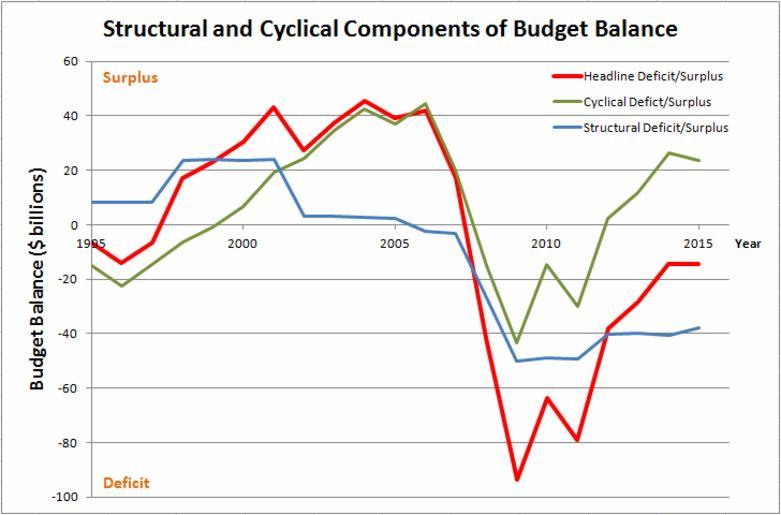MAKE A MEME
View Large Image

| View Original: | Structural & Cyclical Components of Budget, jjron, 21.05.2013.gif (728x480) | |||
| Download: | Original | Medium | Small | Thumb |
| Courtesy of: | commons.wikimedia.org | More Like This | ||
| Keywords: Structural & Cyclical Components of Budget, jjron, 21.05.2013.gif The contributions of structural deficits/surpluses blue and cyclical deficits/surpluses green which are added together to give the overall or headline deficit/surplus red for a hypothetical economy over a twenty year period The structural component blue indicates an underlying imbalance in government revenues and expenditures; in a well-managed balanced budget this should remain close to zero and relatively steady Changes in the structural component suggest that the government has altered policies to do with spending or revenue collection taxation The cyclical component green is largely determined by the business or economic cycle including national and international conditions Changes in the cyclical component are only partially influenced by government policies For example the rapid switch from surplus to deficit around 2007 would be significantly due to the Global Financial Crisis The chart indicates that changes to the headline deficit/surplus red may be deceptive in terms of the underlying structural deficit or surplus For example this economy has a headline deficit in the late 1990s but this is due to cyclical factors rather than the generally healthy structural component During the early to mid-2000s ongoing high headline surpluses indicate a strong economy but it can be seen these surpluses are mainly resulting from cyclical factors while the structural component is actually deteriorating Changes to government policy around this time due to the perceived strong economy increased spending and /or tax cuts lead to a rapid increase in the structural deficit These policy changes coincidentally largely correspond to an unexpected change in cyclical factors in particular the Global Financial Crisis Thus the headline budget balance rapidly shifts to a large deficit It is worth noting that a major economic upheaval such as the GFC may also lead to long-term structural impacts which is also reflected in the rapid shift to deficit for example ongoing major changes in revenues and large numbers of people forced into permanent unemployment or early unexpected retirement The government slowly starts to correct the structural deficit but despite an improvement in economic performance as the cyclical component goes back into surplus the headline budget remains in deficit Note this chart is hypothetical but it is loosely based on the performance of the Australian economy over this time period 2013-05-21 own User Jjron/credit-pd-author User Jjron/credit-pd-permission Public deficit Financial economics Macroeconomics Budget charts 2013 diagrams | ||||